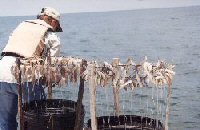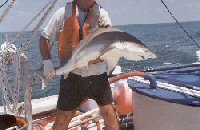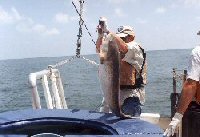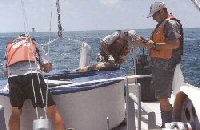Longlining to Monitor Bull Reds off Port Aransas
Tom Wagner, Biologist, Rockport Texas
Have you ever gone down to the river or lake, baited up your trotlines or juglines with cheese or stinkbait, in search of the elusive catfish? Imagine taking your lines, stretching them out to one-quarter mile in length, baiting with squid and dead fish, running six miles out in the Gulf of Mexico, and fishing in water 60 feet deep for bull redfish. That is just what Texas Parks and Wildlife Department, Coastal Fisheries Division biologists have been doing every spring since 1992.
Under a cooperative project funded by Texas Parks and Wildlife and the Southeast Area Monitoring and Assessment Program (SEAMAP), Coastal Fisheries staff headquartered at Rockport, Texas have been longline sampling in the Gulf of Mexico about six miles off Port Aransas. From March through May, the crew deploys eight longline sets for two hours each. The lines are then retrieved by hydraulic winch, all catch are identified by species, measured, and released alive when possible. In the 13 years of sampling since the program’s inception in 1992, 108 longline sets have been completed catching 1,575 organisms. Of this catch, 52% were red drum, 23% were Atlantic sharpnose shark, and 5% were hardhead catfish.

A typical day begins before dawn when the captain and crew gather at the Rockport Marine Lab to load up for the day. Gear, including gangions, hooks and anchors, are stowed on the back deck, as are ice chests full of bait and ice. Bait consists of squid and dead spot croaker caught from TPWD’s routine trawl samples. The run from Rockport to the fishing grounds off Port Aransas typically takes 1-2 hours, allowing the crew time to eat a hearty breakfast of greasy taquitos, a south Texas tradition. Their destination is an unmarked artificial reef area known as the Boatman’s Reef, consisting of an aggregation of concrete blocks submerged at a depth of about 60 feet.

Each of the captain and crew have specific duties, including running the boat, deploying the line from a hydraulic winch, and baiting hooks and attaching them to the quarter-mile longline. Hydrological data including water temperature, salinity, and dissolved oxygen content are recorded, and then the line fishes for the next two hours.

Gear retrieval is a hectic and often dangerous operation, with hooks often flying over the transom if sea conditions are rough. As fish are brought onboard, they are placed temporarily in a container of recirculating seawater for later processing. Once all 100 hooks are brought onboard, the crew begins rapidly deflating air bladders from fish which ascended rapidly from the gulf floor 60 feet below. Healthy fish are tagged and released, with the hope of future recovery to gain biological information on growth and migration. All fish and invertebrates are identified by species, measured and recorded on data sheets. A certain number of adult redfish are saved for spawning stock, and delivered to TPWD’s saltwater hatchery, CCA-CPL Marine Development Center, located in nearby Corpus Christi.

Among the 1500 + organisms caught during this study are several interesting species of fish. Atlantic sharpnose sharks are commonly caught, as are spinner, blacktip, bull, and bonnethead sharks. Game fish such as red snapper, king mackerel, cobia and black drum have been caught, along with one tarpon. Snake eels, some up to six feet in length and 6 inches in diameter, present the crew with a challenge to measure as they are squirming around on deck and striking with razor-sharp teeth.
Since 1992, nearly 400 adult red drum have been used as broodstock for the saltwater hatchery, and over 300 were tagged and released. Only two tagged fish from the study have been recaptured, a red snapper which did not move from its release location, and a red drum captured from the gulf off Port O’Connor nearly 50 miles to the north. Although some of the fish die, they are useful for biological and educational purposes. Otoliths, small bones in the fish’s skull, are collected and used to study age and growth. Numerous fish are taken to local schools and fishing/hunting shows, where the public can observe fish species they might otherwise never see. Over 50 shark specimens were donated to a college student for his Master’s thesis project.
Longlines are an effective means of monitoring adult red drum populations in Texas gulf waters. This gear and sampling location provides TPWD managers with size and abundance data on spawning-size red drum which are not captured in seine and net samples in the bay. In addition, longline-caught red drum provide a reliable source of broodstock to TPWD saltwater hatcheries, enabling hatchery managers to maintain genetic variability in their broodstock.
© Copyright Texas Parks and Wildlife Department. No part of this work may be copied, reproduced, or translated in any form or medium without the prior written consent of Texas Parks Wildlife Department except where specifically noted. If you want to use these articles, see Site Policies